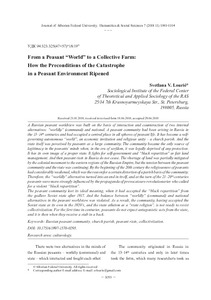From a Peasant “World” to a Collective Farm: How the Preconditions of the Catastrophe in a Peasant Environment Ripened
Скачать файл:
URI (для ссылок/цитирований):
https://elib.sfu-kras.ru/handle/2311/71769Автор:
Lourié, Svetlana V.
Лурье, С.В.
Дата:
2018-07Журнал:
Журнал Сибирского федерального университета. Гуманитарные науки. Journal of Siberian Federal University. Humanities & Social Sciences;2018 11 (7)Аннотация:
A Russian peasant worldview was built on the basis of interaction and counteraction of two internal alternatives: “worldly” (communal) and national. A peasant community had been arising in Russia in the 13–14th centuries and had occupied a central place in all spheres of peasant life. It has become a self-governing autonomous “world”, an economic institution and religious unity – a church parish. And the state itself was perceived by peasants as a large community. The community became the only source of legitimacy in the peasants’ minds when, in the era of serfdom, it was legally deprived of any protection. It has its own image of a proper state. It fights for self-government and “black repartition” as fair land management. And then peasant riots in Russia do not cease. The shortage of land was partially mitigated by the colonial movement to the eastern regions of the Russian Empire, but the tension between the peasant community and the state was continuing. By the beginning of the 20th century the religiousness of peasants had considerably weakened, which was the reason for a certain distortion of a parish basis of the community.
Therefore, the “worldly” alternative turned into an end in itself, and at the turn of the 21–20th centuries peasants were more strongly influenced by the propaganda of provocateurs-revolutionaries who called for a violent “black repartition”.
The peasant community lost its ideal meaning, when it had accepted the “black repartition” from the godless Soviet state after 1917. And the balance between “worldly” (communal) and national alternatives in the peasant worldview was violated. As a result, the community, having accepted the Soviet state as its own in the 1920’s, and the state atheism as a “state religion”, is not ready to resist collectivization. For the first time in centuries, peasants do not expect antagonistic acts from the state, and it is then when they receive a stab in a back Русская крестьянская картина мира строилась на взаимодействии и противодействии двух
внутренних альтернатив: «мирской» (общинной) и государственной. Община, возникнув
на Руси в XIII–XIV вв., заняла центральное место во всех сферах жизни крестьянина, став
и самоуправляющимся автономным «миром», и экономическим институтом, и религиозным
единством — церковным приходом. Да и само государство воспринималось крестьянами как
большая община. В эпоху крепостничества община, юридически лишенная всякой защиты,
в понимании крестьян становится единственным источником легитимности. Она, опираясь
на присутствующий в сознании крестьян образ должного государства, борется за самоуправление и «черный передел» как справедливое землеустройство, и крестьянские бунты в России
не затихают.
Помимо малоземелья, частично смягчаемого только колонистским движением в восточные
регионы Российской империи, продолжающимся напряжением между «миром» и государством, причиной революционизации крестьянской общины к XX в. стало определенное иска-
жение ее приходского начала с заметным ослаблением религиозности крестьян, без которой
«мирская» альтернатива превращалась в самоцель. И на крестьян рубежа ХIХ и ХХ вв. сильнее подействовала пропаганда провокаторов-революционеров, призывавших к насильственно-
му «черному переделу».
После 1917 г., приняв «черный передел» от безбожного советского государства, община утратила свой идеальный смысл, а баланс между мирской и государственной альтернативами
в крестьянской картине мира был нарушен. В результате община, приняв в 1920-е гг. советское государство как свое, а государственный атеизм как «государственную религию», оказывается неготовой противостоять коллективизации. Впервые за века крестьяне не ожидают
от государства враждебных действий, и именно тогда получают от него удар в спину
Метаданные:
Показать полную информациюСвязанные материалы
Показаны похожие ресурсы по названию, автору или тематике.
-
Flash Fiction by M.A. Tarkovsky in the Context of Traditionalism: the End of Direction vs. Different Prospect
Valyanov, Nikita A.; Вальянов, Н.А. (Сибирский федеральный университет. Siberian Federal University, 2016-05)Flash fiction of the contemporary Siberian writer M.A. Tarkovsky is considered by critics and literary scholars in the context of late traditionalism. The motive of chaos and loss of national / traditional, relevant for ... -
Cognitive Opportunities of One Historical Document
Zandanova, Larisa V.; Занданова, Л.В. (Сибирский федеральный университет. Siberian Federal University., 2014-11)In the article the author studies problems of the country modernization and the related processes of agricultural collectivization and dekulakization (the peasantry dispossession of “kulaks” – wealthy peasants), which ... -
Russian Old-Timer’s Society in the Socio-Ecosystem of Yenisei Siberia in the 18-19th Centuries
Andyusev, Boris Е.; Drozdov, Nikolay I.; Андюсев, Б.Е.; Дроздов, Н.И. (Сибирский федеральный университет. Siberian Federal University., 2014-11)We are conducting research on the mutual influence of natural and ecological, cultural and economic, socio-political and other components of the 18th -19th century Yenisei Siberia on the basis of introducing the term of ... -
RESETTLEMENT OF PEASANTS FROM EUROPEAN PART OF RUSSIA TO SIBERIA IN THE LATE XIX – EARLY XX CENTURIES FROM THE STANDPOINT OF FRONTIER THEORY
Baksheev, A. I.; Yurchuk, G. V.; Rukavitsyna, E. A.; Petrov, M. A.; Korol, L. G.; Rakhinsky, D. V. (2019)The purpose of the study is to analyze Frontier Theory and its use in the study of peasant's settlement in Siberia after the abolition of serfdom. Both, general scientific and special methods of historical science were ...

